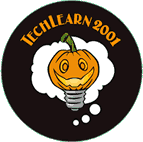- Approaches to Content
- Interoperability and
- Rusability
- Reusable Learning Objects
- Parts of the System
- Content Aggregation
- Communicating with Content
- Metadata
- Links
- Standards Organizations
- Articles
- Copyright notice
- Credits

Learning objects are the core concept in an approach to learning content in which content is broken down into "bite size" chunks. These chunks can be reused, independently created and maintained, and pulled apart and stuck together like so many legos.
Although learning objects are conceptually appealing, exactly what constitutes a learning object in practice has been unclear. In the past different vendors have had different ways of instantiating the notion of a learning object and different ways of enabling learning objects to communicate information about the learner.
Fortunately, as Yogi Berra might have said, the past is history now.
Thanks to the efforts and cooperation of many standards organizations and the vendor community, there are now widely adopted standards that allow learning objects to be described, assembled, delivered, and tracked* in a standardized way, regardless of their shape, size, or intended purpose. This goal of this tutorial is to give an overview of
- The learning object approach to creating learning content
- The advantages (and disadvantages) of this approach
- How learning objects are being implemented today
- Where to look for more information
Enjoy!
*tracking means recording scores, time spent, and other similar parameters.